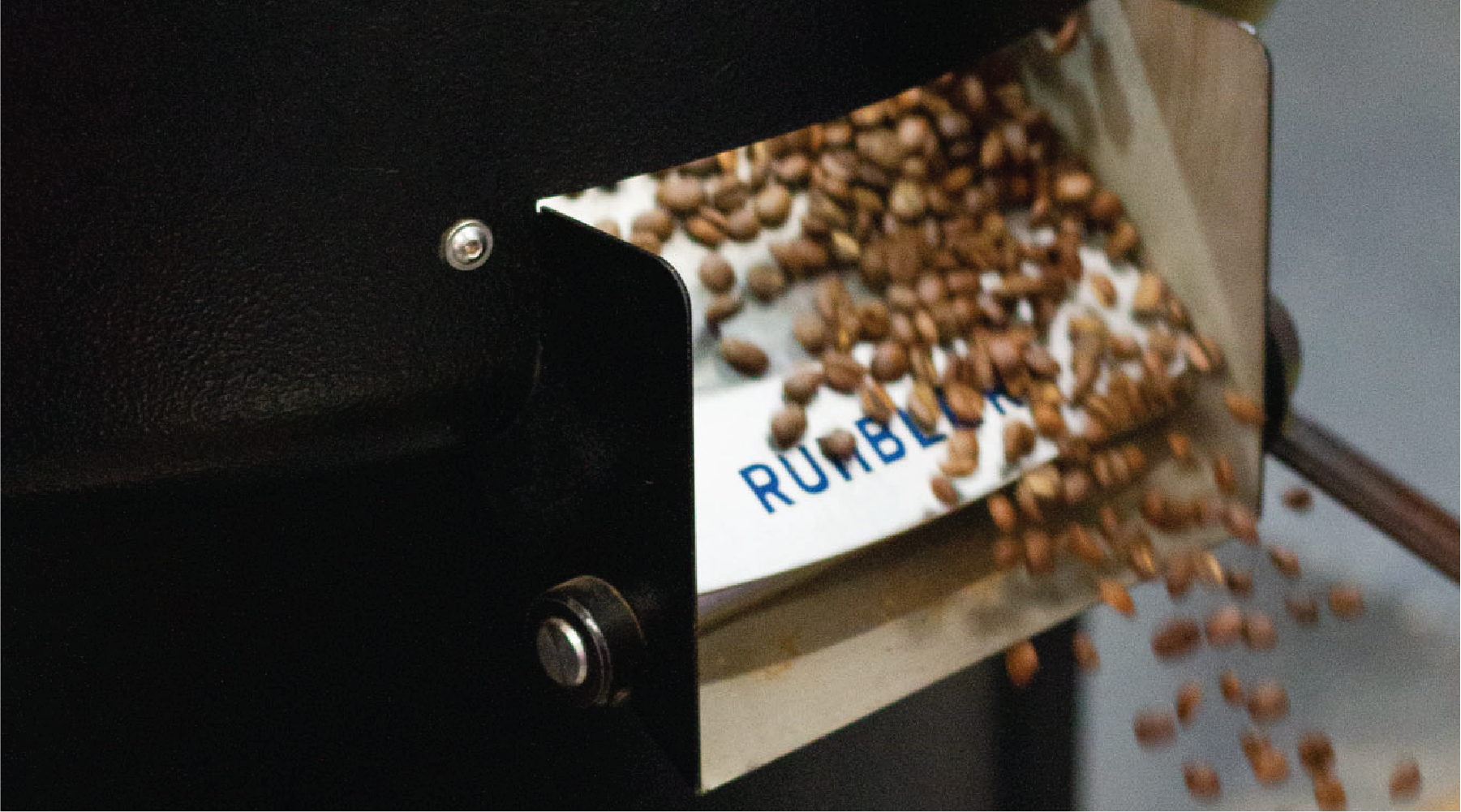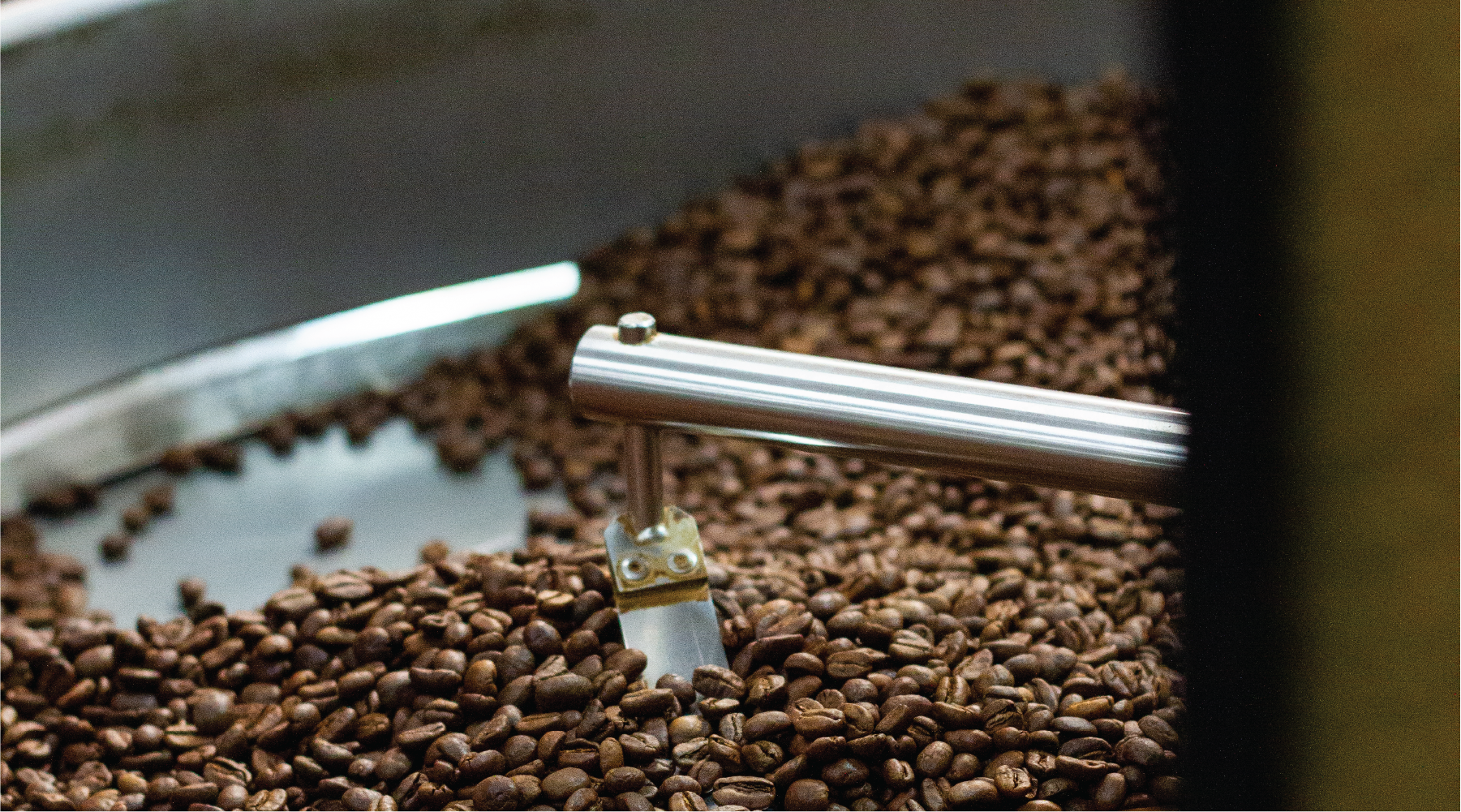
The Art and Science of Coffee Roasting: Behind the Scenes at Rumble Coffee Roasters
At Rumble Coffee, we take pride in delivering the finest specialty coffee to our customers, and central to the process is the art of coffee roasting. Roasting coffee is a delicate balance of time, temperature, and technique to transform green coffee beans into the aromatic, flavourful roasted coffee we all know and love. Join us as we explore the coffee roasting process and reveal the secrets behind the exceptional taste of our coffee.
The Journey Begins: Green Coffee Beans
Coffee begins its journey as green coffee beans, the seeds of the Coffea plant’s fruit, known as the coffee cherry. Green beans are selected, processed, and sorted to ensure only the highest quality beans make it to the roasting stage. Green coffee beans are dense, tasteless, and odourless - a far cry from the final product that ends up in your cup. You need to apply heat over time to unlock the deliciousness inside the green and the best way to do that is inside a roasting chamber.

The Roasting Process: A Symphony of Heat and Time
The coffee roasting process is where the magic happens. It involves applying heat to green coffee to coax out its hidden flavours, aromas, and unique characteristics. The roasting process can be broken down into several key stages:
-
Drying Stage: Here green coffee beans are introduced to the roaster, where they are heated to remove any residual moisture. This stage is crucial for preparing the beans for the upcoming chemical reactions to will unlock their full potential.
-
Maillard Reaction: As the beans reach around 150°C (300°F), the Maillard reaction (or browning stage) occurs. This chemical reaction between amino acids and reducing sugars results in hundreds of complex flavour compounds. At this stage, the beans turn from green to a light brown colour.
-
First Crack: When the beans reach around 380°F (193°C), they emit an audible cracking sound, known as the “first crack.” This results from the beans expanding and releasing moisture and carbon dioxide. First crack is considered the starting point for developing the desired flavour profile.
-
Roast Development: The time between the first crack and the final desired roast level is critical for developing the beans’ flavour, body, and acidity. The roaster monitors and controls the roasting process to bring out the best in each bean.
-
Second Crack (Optional): For darker roasts, the beans may undergo a second crack, which occurs around 435°F (224°C). The high temperatures result in the breakdown of cellular structures and the release of oils, leading to a bolder, more robust flavour profile. At Rumble, even our darkest roasts finish before second crack.
-
Cooling and Degassing: Once the desired roast level is achieved, the beans are dropped from the drum of the roaster into the cooling tray and cooled to stop roasting. After cooling, the beans may “degas” for a period, releasing carbon dioxide and stabilizing their flavour profile. Therefore it’s best to use coffee with five to seven days age for espresso.
Roast Profiles
Roast profiles are the recipes we follow to get the best out of our green coffee and ensure consistency from roast to roast. Even if you start with great coffee, you still need to get the best out of every roast.

Profiles play a huge role in shaping the flavours, aromas, and characteristics of coffee, and understanding them is essential for achieving the perfect roast. At Rumble, we use Cropster, an innovative roast management software, to help us create and maintain consistent roast profiles. Cropster allows us to monitor and control every aspect of the roasting process in real-time, including temperature, time, and rate of rise (ROR). By logging and analyzing data from each roast, we can identify trends, make informed adjustments, and replicate successful roast profiles with precision.
This means our customers can enjoy the same rich, diverse flavours and aromas every time they drink our coffee. Cropster’s advanced technology, combined with our expertise, guarantees each batch of Rumble coffee is roasted to perfection, every single time.
Different roast types:
Each brewing method has unique characteristics that affect the extraction of flavours from coffee beans. At Rumble Coffee Roasters, we take this into account when developing our roast profiles and roast for two different major methods, espresso or filter.
-
Espresso: For our espresso roasts, we focus on creating a balanced flavour profile with a rich, velvety body. By developing the beans a little longer in the roasting process, we achieve a delightful sweetness that shines through in every espresso shot. Our espresso roasts are around 12 minutes long. Check out our current espresso coffees here.
-
Filter: Our filter roasts highlight the beans’ natural acidity and fruity notes. With a lighter roast, we ensure the delicate nuances of each bean are preserved, resulting in a clean and complex cup. Our current lineup of filter roasts is available here.
What about Omniroasting?
Omniroasting is a different approach to coffee roasting that aims to create a roast profile to suit both espresso and filter brewing.

This method breaks away from the traditional practice of developing separate roast profiles for each brewing method, often resulting in lighter roasts for filter coffee and darker roasts for espresso. By balancing between the two, omniroasting emphasises the unique flavours, aromas, and characteristics inherent to the green coffee, regardless of the brewing method. This approach offers several benefits, including reduced production complexity, lower inventory requirements, and a more consistent showcase of a coffee’s origin and quality across various brewing methods.
Saying this, we don’t use an omiroasting approach, as we find we get the best coffee by roasting for filter and espresso.
A Deeper Dive into Roasting Types:
There are two main types of coffee roasting machines, drum roasters and hot air or fluid bed roasters. Both can roast magnificent coffee, but they do so in different ways.
Roasting Types:
-
Drum Roasting: This traditional roasting method uses a rotating drum heated by a gas flame to ensure even heat distribution. The constant movement of the beans allows for precision in the roasting process, which is essential for extracting the finest flavours. At Rumble Coffee Roasters, we utilise state-of-the-art drum roasters to create an array of roast profiles to cater to different preferences and brewing methods.
-
Air Roasting: Also known as fluid bed roasting, this technique uses hot air to levitate the beans, creating a more uniform roast. While we use drum roasting, we are always looking at different methods, like air roasting, to push the boundaries of coffee flavour and complexity.
At Rumble, we have three different roasters: a Probat P-12 and a Loring S35 Kestrel for production roasting and an Ikawa for sample roasting. The Probat and Loring are both drum roasters but different in the way they heat the drum and roast coffee.
Probat
Our Probat P-12 takes care of our filter roasts and single-origin espresso coffee, as we find its hands-on nature lets us get the best out of our high-quality coffees. It allows us to use small batches and to adjust the parameters to strive for the perfect roast.
Probat is renowned for its exceptional craftsmanship, reliable performance, and unparalleled consistency in the industry. Founded in 1868, they prove all the cliches about German engineering true.

Their robust construction and precision engineering ensure even heat distribution and optimal airflow within the roasting drum, enabling roasters to achieve a uniform roast and unlock the full flavour potential of each bean.
They boast advanced controls and monitoring systems, which provide roasters with precise control over variables such as temperature, drum speed, and roast time. This precision allows for the creation and replication of consistent roast profiles that stress the unique characteristics of each coffee origin.
Probat’s long-standing reputation for durability and reliability ensures that its roasters are built to withstand the demands of high-volume coffee production while maintaining consistent performance. Last, Probat offers comprehensive support and resources for its users, from training and technical help to a vast network of experienced roasters, fostering an environment of continuous learning and improvement.
Loring
Our Loring S35 Kestrel handles the bulk of our espresso blends, contract roasting and larger volume roasts.
A Loring roaster is a distinct type of coffee roasting machine that sets itself apart from traditional drum roasters through its innovative design and advanced technology. Here are a few key differences between a Loring roaster and a conventional drum roaster:
-
Recirculating Hot Air System: While traditional drum roasters rely on direct heat transfer from a flame or heating element, Loring roasters utilise a recirculating hot air system. This method results in more even heat distribution and greater control over the roasting process, ensuring a consistent and uniform roast.
-
Energy Efficiency: Loring roasters are more energy efficient than traditional drum roasters. The recirculating hot air system reduces the amount of fuel needed to heat the roasting drum, leading to energy savings of up to 80%. This not only lowers operating costs but also makes Loring roasters more environmentally friendly.
-
Smoke Elimination: Loring roasters are equipped with an integrated afterburner system to reduce smoke emissions. This feature eliminates the need for a separate afterburner, which is often required with traditional drum roasters to meet environmental regulations. The result is a cleaner, more eco-friendly roasting process.
-
Precise Control: Loring roasters offer high control over the roasting process, thanks to their advanced software and automation capabilities. Roasters can monitor and adjust variables like temperature, airflow, and drum speed, allowing them to create consistent roast profiles with greater precision.
-
Reduced Bean Loss: Traditional drum roasters often experience a small percentage of bean loss because of the chaff collector’s inefficiency. Loring roasters feature an efficient cyclone chaff collection system to eliminate bean loss, maximise yield, and reduce waste.
Ikawa
An Ikawa roaster is a compact, precise machine designed for coffee roasteries to roast small batches of green coffee. We receive samples of green coffee throughout the year from the coffee growers we work with and our export partners. We need to roast these samples of green coffee in a consistent and repeatable manner. For a longer read on sample roasting, check out our post here.
The Ikawa uses advanced hot air technology to ensure even and consistent roasting, allowing you to fine-tune and replicate roast profiles with ease. The Ikawa roaster can be controlled via a smartphone app, making it super simple to adjust and monitor. Its sleek design and efficient performance make it an invaluable tool for quality control and sample roasting in a professional setting.
Continuous Learning and Improvement:
The world of coffee roasting is ever-evolving, and at Rumble Coffee Roasters, we embrace the opportunity to grow and learn continuously. By staying informed of the latest research, techniques, and trends, we remain at the forefront of the specialty coffee industry. Our commitment to ongoing education and experimentation ensures that we will always bring you the most innovative and exceptional coffee experiences.
The art and science of coffee roasting are deeply rooted in our passion for creating extraordinary coffee moments. By combining time-tested techniques with innovative technology, we continue to push the boundaries of flavour and complexity. Whether it’s a comforting French press, a vibrant pour-over, or a decadent espresso, we invite you to join us in celebrating the magic of coffee roasting, one cup at a time.
